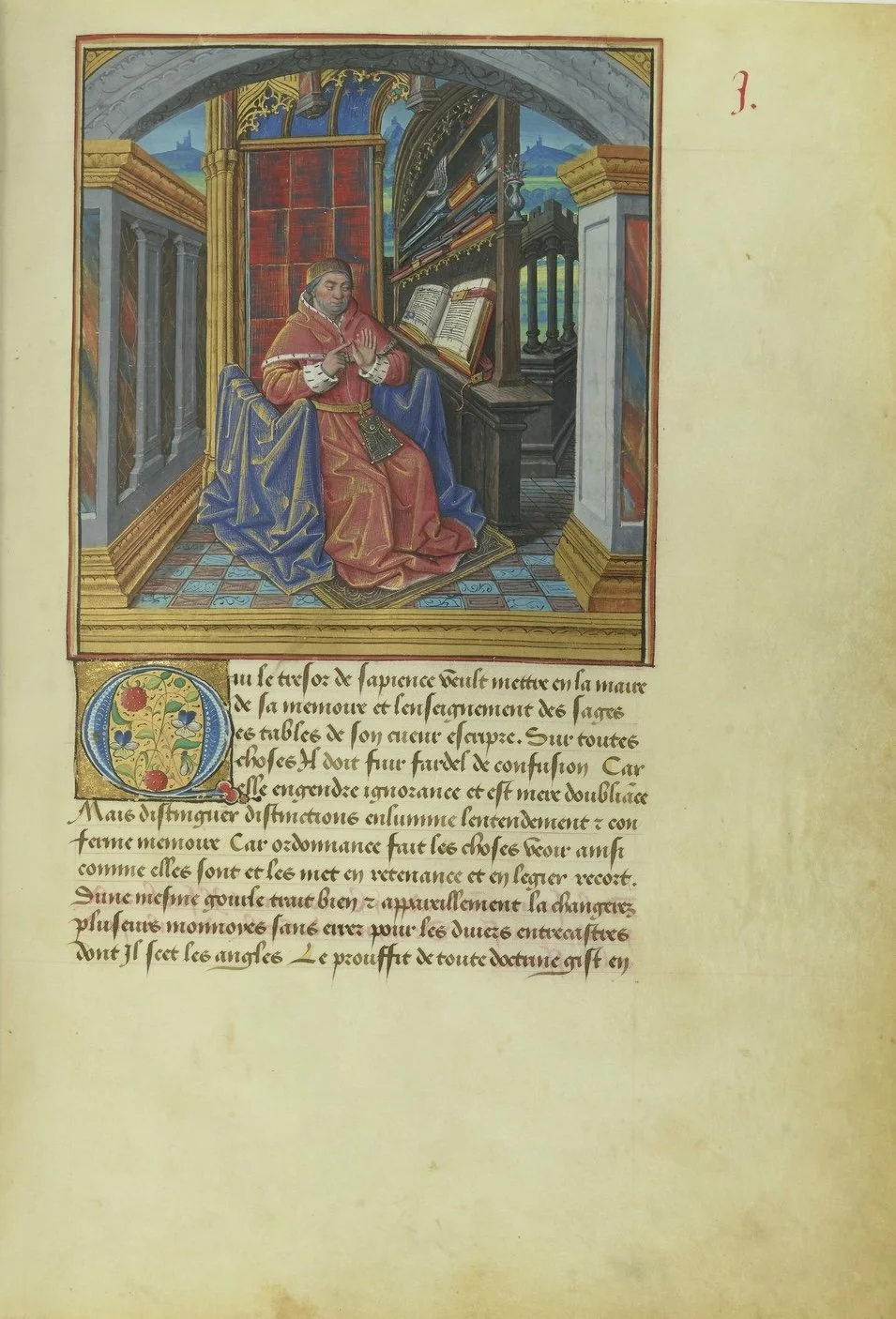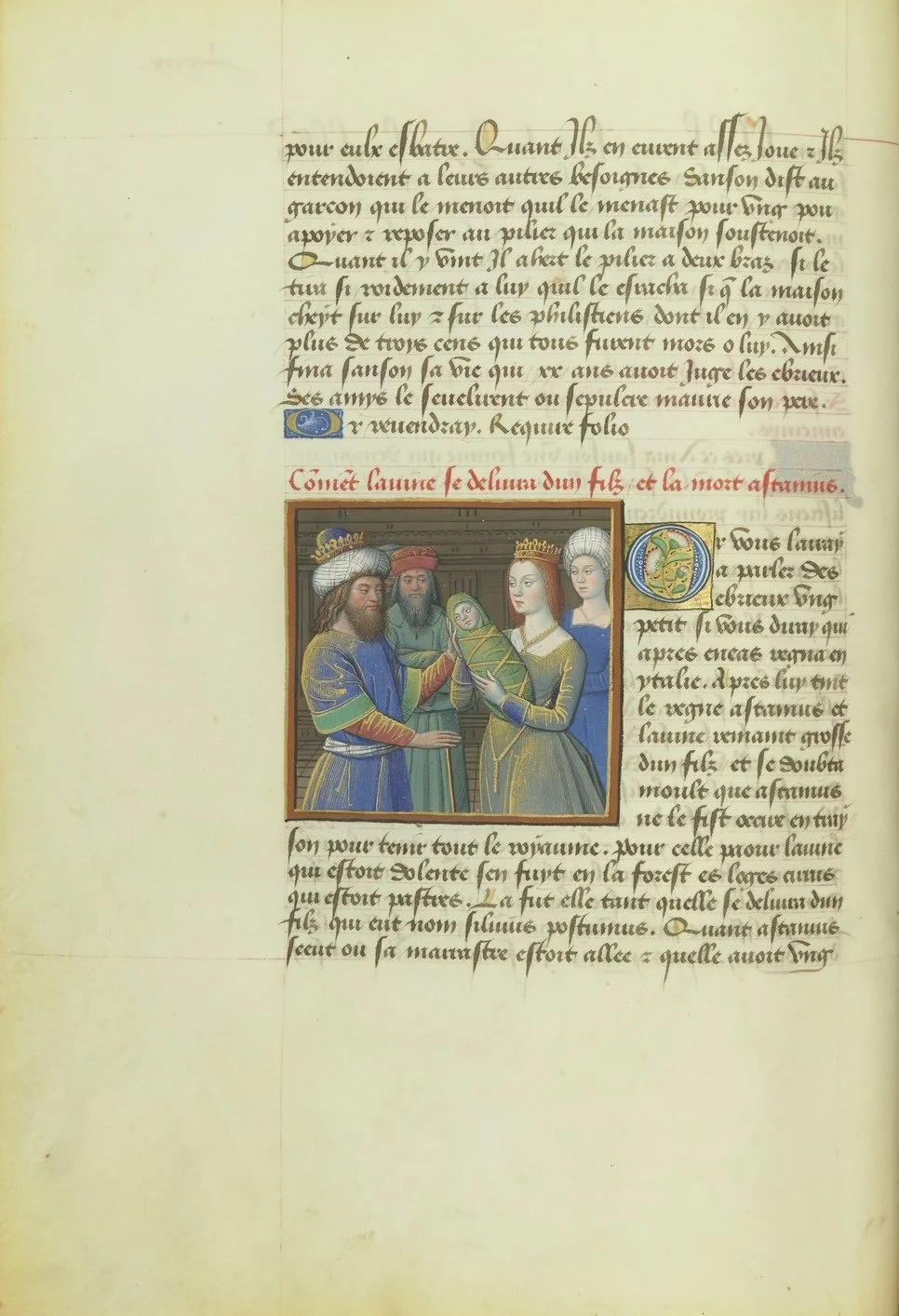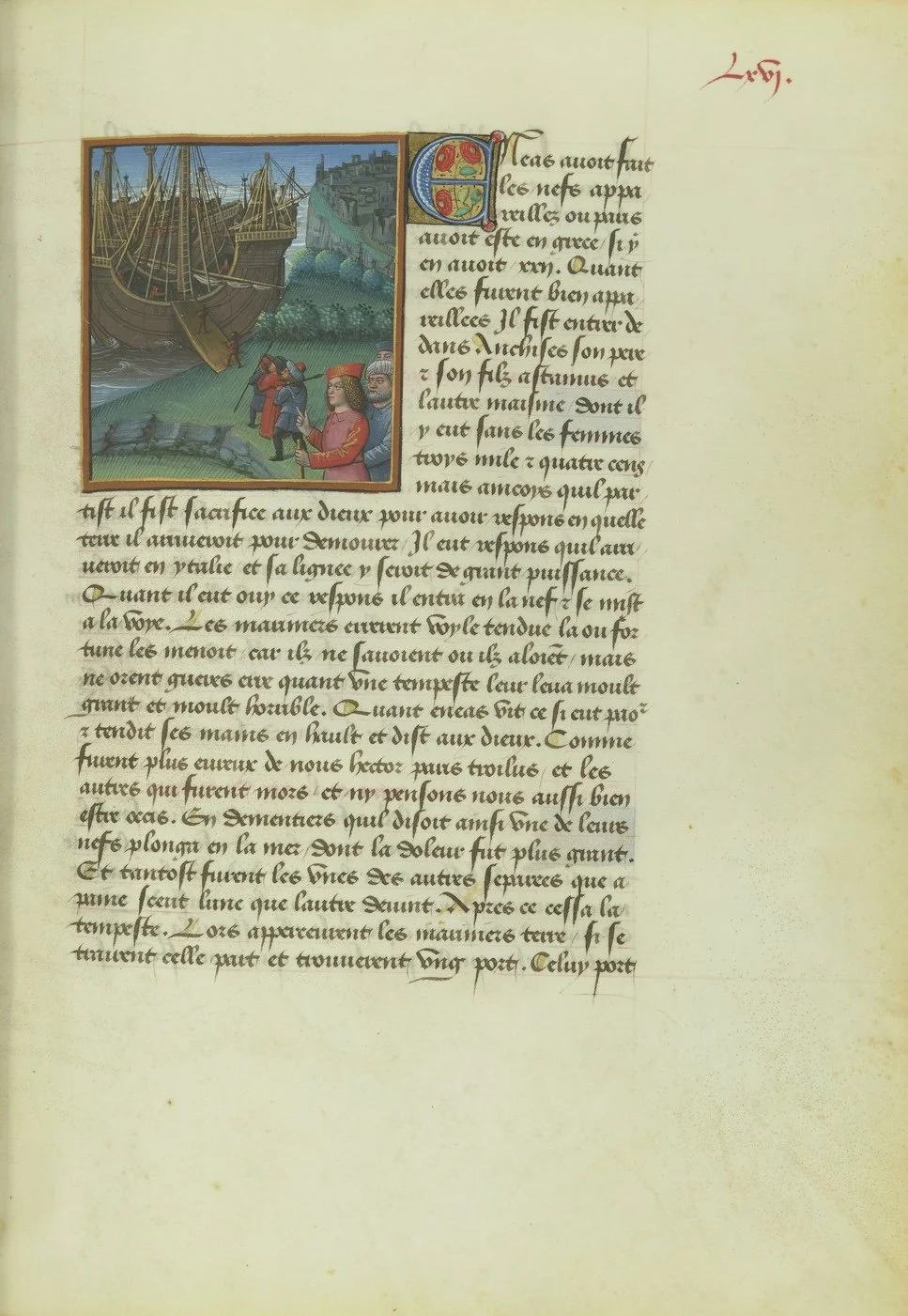The Heart, the Mind and the Cross: Rediscovering Three Manuscripts by the Master of the Beaussant Altarpiece
Reconstructing an artist’s identity from scattered works can be like piecing together a lost manuscript with each fragment revealing part of a greater whole. The Master of the Beaussant Altarpiece is one such elusive figure, known through a handful of illuminated manuscripts, single leaves and one remarkable rediscovered panel painting.
For decades, this artist was identified as the Master of the Paris Cœur d’Amour Épris, named after one of his most beautiful manuscripts. But in 2003, restorers at Angers Cathedral uncovered a Crucifixion hidden beneath a seventeenth century painting. The hand was unmistakable: the illuminator of the Cœur d’Amour Épris. Renamed the Master of the Beaussant Altarpiece after its donor, General Beaussant, this rediscovery transformed our understanding of one of the most refined artists of late fifteenth century France.
To appreciate his achievement, it is worth returning to the three great manuscripts that define his art, all now preserved in the Bibliothèque nationale de France: the Livre du Cœur d’Amour Épris, the Trésor de Sapience and the Vie de Saint François. Together they reveal a painter of grace, intelligence and depth.
![René_d'Anjou_Le_livre_du_[...]_btv1b60005361_43(2).jpeg](https://images.squarespace-cdn.com/content/v1/658f779f0adca0579ba4fc34/1760520528374-P8PWW1DCQVZ8HMNWO6UQ/Rene%CC%81_d%27Anjou_Le_livre_du_%5B...%5D_btv1b60005361_43%282%29.jpeg)
![René_d'Anjou_Le_livre_du_[...]_btv1b60005361_7.jpeg](https://images.squarespace-cdn.com/content/v1/658f779f0adca0579ba4fc34/1760520527974-95GXPGZLXEE7WB67RUIC/Rene%CC%81_d%27Anjou_Le_livre_du_%5B...%5D_btv1b60005361_7.jpeg)

![René_d'Anjou_Le_livre_du_[...]_btv1b60005361_265(1).jpeg](https://images.squarespace-cdn.com/content/v1/658f779f0adca0579ba4fc34/1760520526753-IOFA1ODNJJ8N3NJH0QBB/Rene%CC%81_d%27Anjou_Le_livre_du_%5B...%5D_btv1b60005361_265%281%29.jpeg)
![René_d'Anjou_Le_livre_du_[...]_btv1b60005361_317.jpeg](https://images.squarespace-cdn.com/content/v1/658f779f0adca0579ba4fc34/1760520525489-4YOE6I7KDUMG7K8GI1GD/Rene%CC%81_d%27Anjou_Le_livre_du_%5B...%5D_btv1b60005361_317.jpeg)
![René_d'Anjou_Le_livre_du_[...]_btv1b60005361_352(1).jpeg](https://images.squarespace-cdn.com/content/v1/658f779f0adca0579ba4fc34/1760520524086-XIDUV52ANSWOX58JW9PU/Rene%CC%81_d%27Anjou_Le_livre_du_%5B...%5D_btv1b60005361_352%281%29.jpeg)
![René_d'Anjou_Le_livre_du_[...]_btv1b60005361_348.jpeg](https://images.squarespace-cdn.com/content/v1/658f779f0adca0579ba4fc34/1760520524348-OLB4WZC1R20IMVWB98TH/Rene%CC%81_d%27Anjou_Le_livre_du_%5B...%5D_btv1b60005361_348.jpeg)
![René_d'Anjou_Le_livre_du_[...]_btv1b60005361_338(1).jpeg](https://images.squarespace-cdn.com/content/v1/658f779f0adca0579ba4fc34/1760520525847-CX223GCK7ENZTOY5NCNK/Rene%CC%81_d%27Anjou_Le_livre_du_%5B...%5D_btv1b60005361_338%281%29.jpeg)
René d'Anjou , Le livre du Coeur d'amour épris, France, Anjou, c. 1460-1485, 138 folios, 70 miniatures by the Master of the Beaussant Altarpiece, 310 × 215 mm, Bibliothèque nationale de France. Département des Manuscrits. Français 24399.
The Livre du Cœur d’Amour Épris, the allegorical romance written by King René d’Anjou (1409–1480), stands at the center of the Beaussant Master’s identity. Preserved in the Bibliothèque nationale de France (Fr. 24399), it defined his earlier name, the Master of the Paris Cœur d’Amour Épris. René d’Anjou, “le bon roi René,” was both ruler and humanist, a poet, artist and patron who fostered a cosmopolitan court spanning Anjou, Provence and Naples. Written around 1457, his Cœur d’Amour Épris tells of a “Heart Seized by Love,” an allegory of moral endurance and chivalric devotion, and is one of the finest expressions of late medieval courtly culture.
The Beaussant Master translated René’s introspective poetry into a sequence of images glowing with deep blues, ruby reds and liquid gold. His figures are poised within elegant, compressed spaces, their gestures deliberate, their faces rendered with precision. He almost certainly knew the earlier, more famous version of the text painted by Barthélemy d’Eyck (Vienna, ÖNB MS 2597). D’Eyck’s atmospheric modeling and psychological subtlety shaped a generation of Angevin artists. The Beaussant Master refined those lessons into a more linear decorative style, uniting Flemish naturalism with French elegance to create a visual language of love and virtue.
Explore the complete manuscript by clicking here









Pseudo–Bonaventure, Le Trésor de Sapience, France, Paris, c. 1470–1475, 255 folios, written in French, 68 miniatures by the Master of the Beaussant Altarpiece, 310 × 215 mm, Bibliothèque nationale de France, Département des Manuscrits, Français 1367.
If the Cœur d’Amour Épris reflects poetic sensibility, the Trésor de Sapience (The Treasure of Wisdom) reveals the artist’s intellectual and moral depth. Preserved in the Bibliothèque nationale de France (Fr. 1367), this monumental moral compendium translated from the Latin Speculum Sapientiae (“Mirror of Wisdom”) was among the most ambitious manuscripts produced in René d’Anjou’s orbit.
Attributed in the Middle Ages to St. Bonaventure, the text is now thought to have been written by an anonymous theologian in the early fourteenth century. It presents moral dialogues between Virtues and Vices, teaching ethical discernment through allegory and exempla. Its fifteenth century French translation transformed the scholastic treatise into a courtly “mirror for princes,” uniting Christian virtue with classical wisdom.
The Beaussant Master approaches this demanding text with clarity. His 68 compositions are structured like architecture. Where the Cœur d’Amour Épris dazzles with color and imagination, the Trésor impresses with order and harmony, anticipating the early Renaissance ideal of moral beauty expressed through visual geometry. It shows the Beaussant Master at his most assured, translating philosophy into illumination.
Explore the complete manuscript by clicking here
![BONAVENTURE_(saint)_card_O_F_[...]Bonaventura_(saint_btv1b6000237d_196(1).jpeg](https://images.squarespace-cdn.com/content/v1/658f779f0adca0579ba4fc34/1760524235059-YMSZ0P144EHWK6XAJMBU/BONAVENTURE_%28saint%29_card_O_F_%5B...%5DBonaventura_%28saint_btv1b6000237d_196%281%29.jpeg)
![BONAVENTURE_(saint)_card_O_F_[...]Bonaventura_(saint_btv1b6000237d_17.jpeg](https://images.squarespace-cdn.com/content/v1/658f779f0adca0579ba4fc34/1760524238625-6P8S1XKYBQXR7XD4YUYD/BONAVENTURE_%28saint%29_card_O_F_%5B...%5DBonaventura_%28saint_btv1b6000237d_17.jpeg)
![BONAVENTURE_(saint)_card_O_F_[...]Bonaventura_(saint_btv1b6000237d_74(2).jpeg](https://images.squarespace-cdn.com/content/v1/658f779f0adca0579ba4fc34/1760524236194-Z5S66JB2RWSL880RZ2SF/BONAVENTURE_%28saint%29_card_O_F_%5B...%5DBonaventura_%28saint_btv1b6000237d_74%282%29.jpeg)
![BONAVENTURE_(saint)_card_O_F_[...]Bonaventura_(saint_btv1b6000237d_41.jpeg](https://images.squarespace-cdn.com/content/v1/658f779f0adca0579ba4fc34/1760524237598-ETAZ2FOQZWAZWAULD8F2/BONAVENTURE_%28saint%29_card_O_F_%5B...%5DBonaventura_%28saint_btv1b6000237d_41.jpeg)
![BONAVENTURE_(saint)_card_O_F_[...]Bonaventura_(saint_btv1b6000237d_181(1).jpeg](https://images.squarespace-cdn.com/content/v1/658f779f0adca0579ba4fc34/1760524235803-HHRQH89CHTDMP8XOKRNT/BONAVENTURE_%28saint%29_card_O_F_%5B...%5DBonaventura_%28saint_btv1b6000237d_181%281%29.jpeg)
![BONAVENTURE_(saint)_card_O_F_[...]Bonaventura_(saint_btv1b6000237d_56.jpeg](https://images.squarespace-cdn.com/content/v1/658f779f0adca0579ba4fc34/1760524237118-8NNMMAT4XZUYTZ79KJGN/BONAVENTURE_%28saint%29_card_O_F_%5B...%5DBonaventura_%28saint_btv1b6000237d_56.jpeg)
![BONAVENTURE_(saint)_card_O_F_[...]Bonaventura_(saint_btv1b6000237d_230.jpeg](https://images.squarespace-cdn.com/content/v1/658f779f0adca0579ba4fc34/1760524233712-8O5XFTNP7G1HUQG54Q65/BONAVENTURE_%28saint%29_card_O_F_%5B...%5DBonaventura_%28saint_btv1b6000237d_230.jpeg)
![BONAVENTURE_(saint)_card_O_F_[...]Bonaventura_(saint_btv1b6000237d_211.jpeg](https://images.squarespace-cdn.com/content/v1/658f779f0adca0579ba4fc34/1760524234643-8A048TQ9RCB7Z5P3QZVO/BONAVENTURE_%28saint%29_card_O_F_%5B...%5DBonaventura_%28saint_btv1b6000237d_211.jpeg)
![BONAVENTURE_(saint)_card_O_F_[...]Bonaventura_(saint_btv1b6000237d_261(1).jpeg](https://images.squarespace-cdn.com/content/v1/658f779f0adca0579ba4fc34/1760524233494-4I9IXBA6ETT9WUR9TSLC/BONAVENTURE_%28saint%29_card_O_F_%5B...%5DBonaventura_%28saint_btv1b6000237d_261%281%29.jpeg)
Saint Bonaventure, La Vie de Saint François, France, possibly Provence or the Loire Valley, c. 1475–1480, 166 folios, written in French, 46 miniatures by the Master of the Beaussant Altarpiece, 305 × 215 mm, Bibliothèque nationale de France, Département des Manuscrits, Français 28640.
The Vie de Saint François (BNF, Fr. 28640) reveals the Beaussant Master at his most mature. Based on St. Bonaventure’s Légende majeure, the text recounts the saint’s renunciation, visions and death. Scenes of Francis’s life are rendered with restraint rather than theatrical pathos. Likely commissioned for a Franciscan patron within René d’Anjou’s circle, it transforms the artist’s courtly style into one of meditative simplicity. Here the palette softens from lapis and vermilion to muted ochres and greens. Figures inhabit intimate, enclosed spaces; gestures are tender, faces introspective. The manuscript reflects the late-medieval turn toward personal devotion and the imitation of Christ.
Acquired by the Bibliothèque nationale de France in 2008 from a French private collection, the Vie de Saint François stands as the tour de force of the Beaussant Master’s career.
Explore the complete manuscript by clicking here




The Rediscovered Crucifixion and the Naming of the Master
In 2003, restorers working on a seventeenth century panel depicting the Assumption of the Virgin by the Angevin painter G. Durand (1699) in the treasury of the Cathedral of Saint-Maurice, Angers, uncovered traces of an earlier painting beneath the surface. Further analysis revealed a hidden Crucifixion of extraordinary quality.
Beneath the later work emerged a fifteenth century Crucifixion with the Virgin, Saint John and donors, painted on oak panels dated by dendrochronology to between 1468 and 1492. The composition expanded to show Christ calm in his glory, flanked by a Pietà and a kneeling monk donor with Saint Bernard. These paintings bore the unmistakable hand of the illuminator of the Cœur d’Amour Épris.
This revelation led scholars to rename the artist the Master of the Beaussant Altarpiece, after General Beaussant, who donated the restored work to the French State in 2004. It is now displayed in the treasury of the Cathedral of Saint-Maurice, and the Retable Beaussant is the only surviving panel painting securely attributed to the master.
Master of the Beaussant Altarpiece, The Crucifixion with the Virgin and John, and the symbols of the Evangelists, Written in Latin, a leaf from an Oath Book, the opening to Gospel of John, In principio erat verbum… (In the Beginning was the Word…), France, Anjou, (Angers?), circa 1480, 244 x 178 mm.
A Parallel Vision: The Oath Book Crucifixion
A Crucifixion miniature recently added to my website, a leaf from an Oath Book illuminated by the Master of the Beaussant Altarpiece (France, Provence or Loire Valley, c. 1480) portrays a near identical composition to the Retable Beaussant at Angers. Appearing out of a private collection in the United States this unknown leaf is unique. One would presume that being a Crucifixation scene it comes from a Missal but it derives from an Oath Book produced for a confraternity or guild. Exceptionally few illuminated Oath Books survive.
This rare Crucifixion transforms an instrument of sworn truth into a meditation on divine justice. Its crystalline palette and architectural balance reflects the Beaussant Master’s mature, devotional style. It offers a glimpse into the Beaussant Master’s multifaceted genius. He was a painter equally at home in the grandeur of altarpieces and in the intimacy of manuscripts. His art continues to bridge devotion, intellect and beauty across centuries and mediums.


